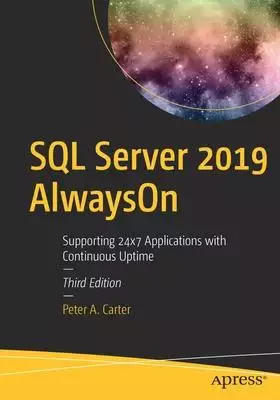Troubleshoot Windows的問題,透過圖書和論文來找解法和答案更準確安心。 我們找到下列包括價格和評價等資訊懶人包
Troubleshoot Windows的問題,我們搜遍了碩博士論文和台灣出版的書籍,推薦Halsey, Mike寫的 Windows 10 Troubleshooting: Learn to Troubleshoot and Repair Windows 10 Problems Like the Pros Do 和Carter, Peter A.的 SQL Server 2019 Alwayson: Supporting 24x7 Applications with Continuous Uptime都 可以從中找到所需的評價。
這兩本書分別來自 和所出版 。
國立高雄科技大學 智慧商務系 李仕雄所指導 邱偉源的 設計與實現一基於MQTT協議之高效率 工業物聯網網關管理平台 (2021),提出Troubleshoot Windows關鍵因素是什麼,來自於工業物聯綱、網關整合平台、微服務系統、裝置管理。
而第二篇論文中國科技大學 資訊工程系資訊科技應用碩士在職專班 蔡輝榮所指導 林芸萱的 主機弱點掃描之研究-以非授權與授權掃描為例 (2020),提出因為有 弱點掃描、授權掃描、非授權掃描的重點而找出了 Troubleshoot Windows的解答。
除了Troubleshoot Windows,大家也想知道這些:
Windows 10 Troubleshooting: Learn to Troubleshoot and Repair Windows 10 Problems Like the Pros Do

為了解決Troubleshoot Windows 的問題,作者Halsey, Mike 這樣論述:
設計與實現一基於MQTT協議之高效率 工業物聯網網關管理平台
為了解決Troubleshoot Windows 的問題,作者邱偉源 這樣論述:
工業物聯網(Industrial Internet of Things 簡稱IIoT)就是把物聯網的應用使用在新創工業及科技產業上,就是將感測裝置、監測儀器以及其他控制設備和電腦的應用程式以網路相連所整合成的系統,而其中包括了製造管理、能源管理及安全上的管理應用,只要透過網路連線就可以進行數據採集、資料交換以及收集後的大數據拿來做整理、分析、預測並做控制,都有助於提升企業生產力、環境安全以及使用效率,也有助於減少資源消耗進而改善經濟效益。 本論文基於某電信企業,對主機房中有大量的溫溼度感測元件、不斷電系統(Uninterruptible Power Supply,稱簡UPS)、機櫃電源
分配器(Power Distribution Unit,簡稱PDU)、空調設備、防火感測器、網路設備..等,在數據收集、位置配置、設備類型、快速定義數據屬性有管理應用上的需求,並且能結合裝置的配置來設計有效率的網關模組來採集在不同協議終端裝置上的數據,並且將採集到的數據轉換成統一格式後再上報到後台訊息中心做應用,所以就以上需求概念,本論文設計並實作了工業物聯網網關管理平台,實作網關軟件模組能面向目前常用的三種工業協定 MODBUS、SNMP、BACnet的終端裝置,並提供方便有效率的操作管理介面供用戶使用,可依實機裝置的遙測數據屬性做採集設定,再將配置發送給網關模組做定時採集,網關採集到的裝置
遙測值後再統一透過工業物聯網最常用的輕量級消息傳遞協定 MQTT(Message Queuing Telemetry Transport)進行輸出傳送到後台訊息中心伺服器EMQX(Erlang/Enterprise/Elastic MQTT Broker,是基于Erlang/OTP 平台開發的開源物聯網MQTT消息服務器),整理上報的遙測資料內容也是採用現今流行的非結構化JSON(JavaScript Object Notation)格式做輸出,解決在大量異質終端設備數據採集不易及管理配置不便的問題。
SQL Server 2019 Alwayson: Supporting 24x7 Applications with Continuous Uptime

為了解決Troubleshoot Windows 的問題,作者Carter, Peter A. 這樣論述:
Get a fast start to using AlwaysOn, the SQL Server solution to high-availability and disaster recovery. This third edition is newly-updated to cover the 2019 editions of both SQL Server and Windows Server and includes strong coverage of implementing AlwaysOn Availability Groups on both Windows an
d Linux operating systems. The book provides a solid and accurate understanding of how to implement systems requiring consistent and continuous uptime, as well as how to troubleshoot those systems in order to keep them running and reliable. This edition is updated to account for all new major functi
onality and also includes coverage of implementing atypical configurations, such as clusterless and domain-independent Availability Groups, distributed Availability Groups, and implementing Availability Groups on Azure.The book begins with an introduction to high-availability and disaster recovery c
oncepts such as Recovery Point Objectives (RPOs), Recovery Time Objectives (RTOs), availability levels, and the cost of downtime. You’ll then move into detailed coverage of implementing and configuring the AlwaysOn feature set in order to meet the business objectives set by your organization. Conten
t includes coverage on implementing clusters, building AlwaysOn failover clustered instances, and configuring AlwaysOn Availability Groups.SQL Server 2019 AlwaysOnis chock full of real-world advice on how to build and configure the most appropriate topology to meet the high-availability and disaster
recovery requirements you are faced with, as well as how to use AlwaysOn Availability Groups to scale-out read-only workloads. This is a practical and hands-on book to get you started quickly in using one of the most talked-about SQL Server feature sets.What You Will LearnUnderstand high availabili
ty and disaster recovery in SQL Server 2019Build and configure a Windows Cluster in Windows Server 2019Create and configure an AlwaysOn failover clustered instanceImplement AlwaysOn Availability Groups and appropriately configure themImplement AlwaysOn Availability Groups on Linux serversConfigure A
vailability Groups on Azure IaaSAdminister AlwaysOn technologies post implementationUnderstand typical configurations, such as clusterless and distributed Availability GroupsWho This Book Is ForFor Microsoft SQL Server database administrators who interested in growing their knowledge and skills in S
QL Server’s high-availability and disaster recovery feature set.
主機弱點掃描之研究-以非授權與授權掃描為例
為了解決Troubleshoot Windows 的問題,作者林芸萱 這樣論述:
隨著網路科技的蓬勃發展,駭客的攻擊手法也跟著日新月異,根據CVE統計,從1999年到2019年弱點(Vulnerability)數量一直不斷在成長,不管是企業、學校、政府機關等單位,都必須正視這件事,在面對駭客千變萬化的攻擊時,除了透過購買各類型的資安防護設備進行阻擋或偵測攻擊外,最根本之道還是必須定期檢視企業內部設備及軟體是否有定期更新,為設備進行弱點掃描(Vulnerability Assessment),因為唯有提早知道設備存在之漏洞風險,並提早進行修補及更新,才能降低資安事件的發生,提高企業內部的安全性。一般在實務上,弱點掃描執行方式都是採非授權掃描(non-credentialed
scans)的方式進行,而不會特別使用授權掃描,根據SIKICH於2019年7月25發布的文章,提到其原因是因為設備管理者會擔心使用授權掃描的方式進行會具侵入性,導致設備服務中斷等可能,所以較不傾向使用授權掃描的方式進行。並提到針對同一台主機進行弱點掃描時,授權掃描(credentialed scans)可使掃描結果更為精確,且能更加準確的識別設備是否存在不安全的設定及因未定期套用修補套件(Patch)所造成的系統弱點,以及發現更多非授權掃描無法檢測到的弱點,在準確度的部分相較非授權掃描來的高。為了找出實務上最適合的弱點掃描方式,本實驗將根據實務經驗彙整出常見的作業系統以及常見弱點,並以統計
結果為基準自建測試環境,再分別針對非授權及授權掃描之結果進行實驗與分析。經實際測試,發現授權掃描相較非授權掃描所花費的掃描時間差距不大,但卻可以為主機找出更多的風險,並且在進行掃描時授權掃描會分別以代入授權及未代入授權的角度對主機進行檢視,因此相較非授權掃描能夠為主機檢查的更為精細及全面,所以以實驗結果來說,建議於實務上進行掃描時以代入授權的方式進行較合適。